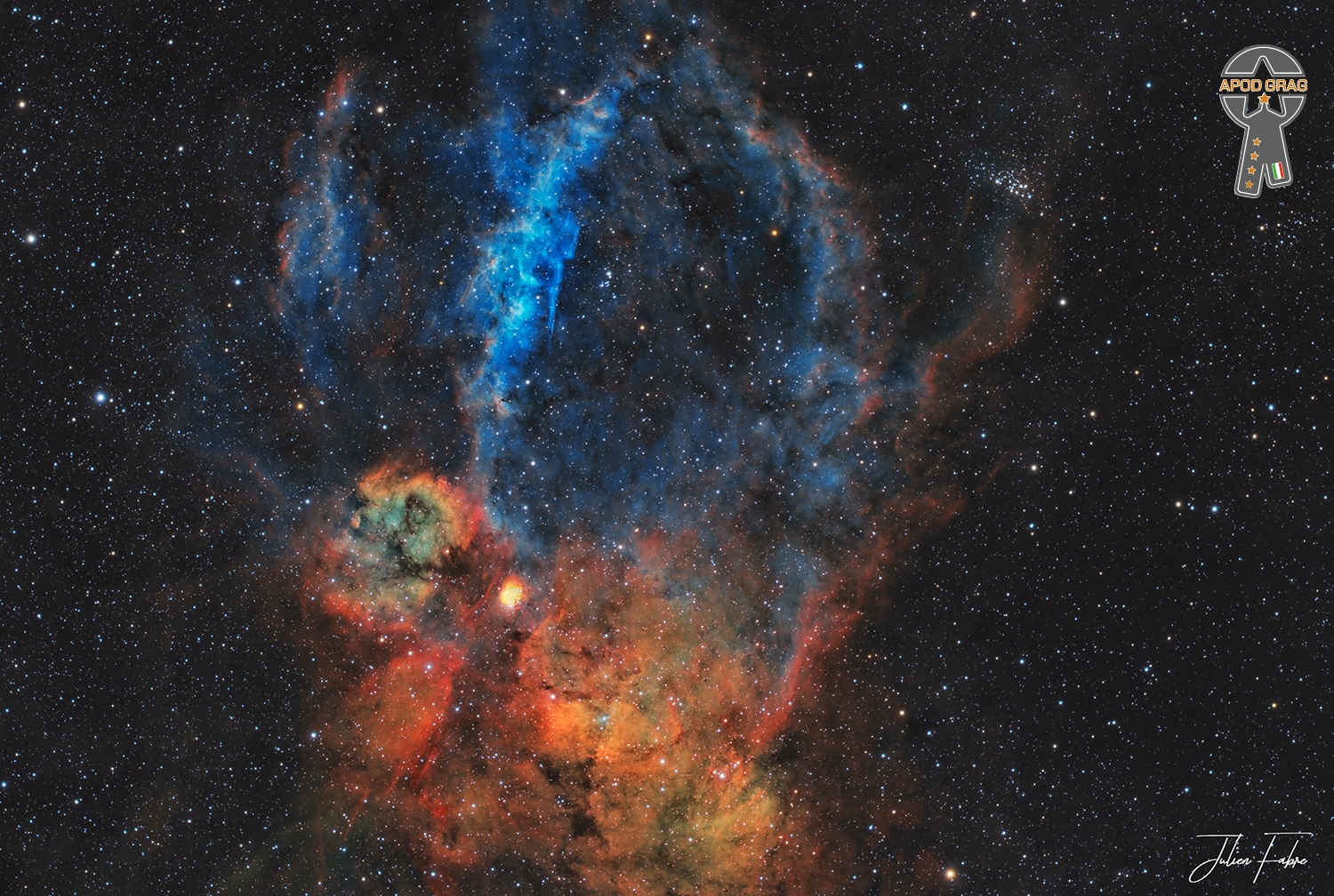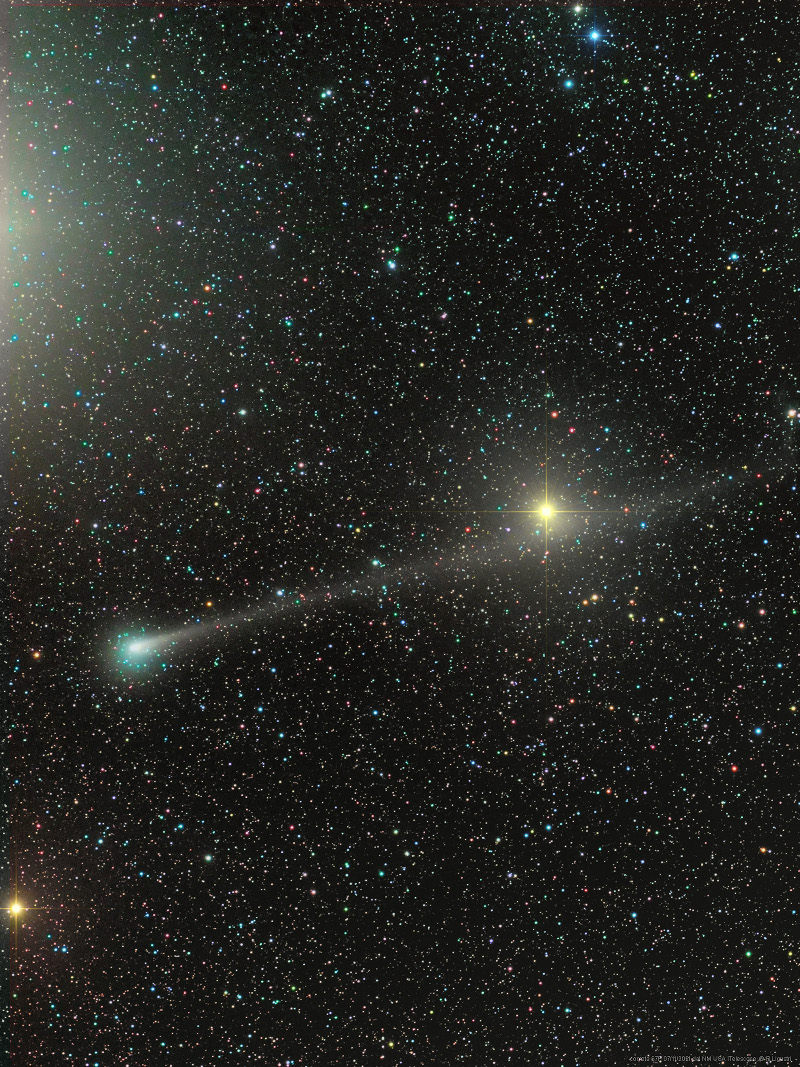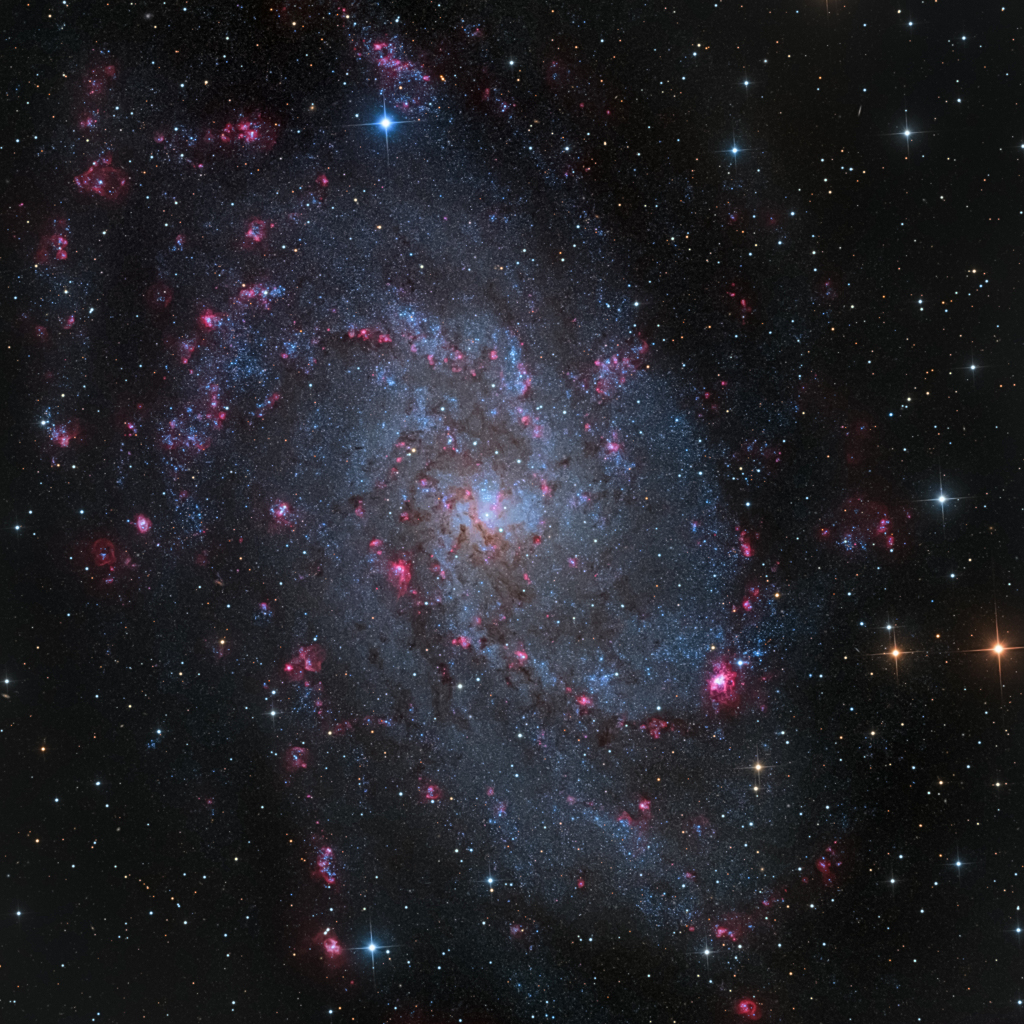Blog
Jerome Richardson (November 15, 1920 – June 23, 2000) was an American jazz musician, tenor saxophonist, and flute player, who also played soprano sax, alto sax, baritone sax, clarinet, bass clarinet, alto flute and piccolo. He played with Charles Mingus, Lionel Hampton, Billy Eckstine, the Thad Jones/Mel Lewis Big Band, Kenny Burrell, and later with Earl Hines‘ small band.
Richardson was born in Oakland, California, United States, and died in Englewood, New Jersey of heart failure at the age of 79.
more...The Lobster Claw Nebula, Sh2-157, is an emission nebula in constellations of Cassiopeia and Cepheus at a distance of 8,000 light years.
The two arcs representing the pincers are thought to be the consequence of a Wolf Rayet star that belongs to the open cluster Markarian 50.
Also note, at the top right of the nebula, the presence of the open cluster NGC7510 located at 11400 Al from us.

Stanley Dural Jr. (November 14, 1947 – September 24, 2016), better known by his stage name Buckwheat Zydeco, was an American accordionist and zydeco musician. He was one of the few zydeco artists to achieve mainstream success. His music group was formally billed as Buckwheat Zydeco and Ils Sont Partis Band (“Ils Sont Partis” being French for “They have left”), but they often performed as merely Buckwheat Zydeco.
The New York Times said: “Stanley ‘Buckwheat’ Dural leads one of the best bands in America. A down-home and high-powered celebration, meaty and muscular with a fine-tuned sense of dynamics…propulsive rhythms, incendiary performances.” USA Today called him “a zydeco trailblazer.”Buckwheat Zydeco performed with famous musicians such as Eric Clapton (with whom he also recorded), U2 and the Boston Pops. The band performed at the closing ceremonies of the 1996 Summer Olympics to a worldwide audience of three billion people. Buckwheat performed for President Clinton twice, celebrating both of his inaugurations. The band appeared on the Late Show with David Letterman, CNN, The Today Show, MTV, NBC News, CBS Morning News, National Public Radio’s Mountain Stage, and Late Night with Jimmy Fallon.
more...George Andrew Cables (born November 14, 1944) is an American jazz pianist and composer.
Cables was born in New York City, United States. He was initially taught piano by his mother. He then studied at the High School of Performing Arts and later at Mannes College (1963–65). He formed the Jazz Samaritans at the age of 18, a band that included Billy Cobham, Steve Grossman, and Clint Houston. Cables’ early influences on piano were Thelonious Monk and Herbie Hancock.
more...Ellis Louis Marsalis Jr. (November 14, 1934 – April 1, 2020) was an American jazz pianist and educator. Active since the late 1940s, Marsalis came to greater attention in the 1980s and 1990s as the patriarch of the musical Marsalis family, when sons Branford and Wynton became popular musicians. Born in New Orleans, Louisiana, Marsalis was the son of Florence Marie (née Robertson) and Ellis Marsalis Sr., a businessman and social activist.Marsalis and his wife Dolores Ferdinand Marsalis had six sons: Branford, Wynton, Ellis III, Delfeayo, Mboya, and Jason. Branford, Wynton, Delfeayo, and Jason also became jazz musicians. Ellis III is a poet and photographer.
Marsalis played saxophone during high school but switched to piano while studying classical music at Dillard University, graduating in 1955. He later attended graduate school at Loyola University New Orleans. In the 1950s and 1960s he worked with Ed Blackwell, Cannonball Adderley, Nat Adderley, and Al Hirt. During the 1970s, he taught at the New Orleans Center for Creative Arts. His students have included Terence Blanchard, Harry Connick Jr., Donald Harrison, Kent Jordan, Marlon Jordan, and Nicholas Payton.
more...Aaron Copland (/ˈkoʊplənd/, KOHP-lənd; November 14, 1900 – December 2, 1990) was an American composer, composition teacher, writer, and later a conductor of his own and other American music. Copland was referred to by his peers and critics as “the Dean of American Composers”. The open, slowly changing harmonies in much of his music are typical of what many people consider to be the sound of American music, evoking the vast American landscape and pioneer spirit. He is best known for the works he wrote in the 1930s and 1940s in a deliberately accessible style often referred to as “populist” and which the composer labeled his “vernacular” style. Works in this vein include the ballets Appalachian Spring, Billy the Kid and Rodeo, his Fanfare for the Common Man and Third Symphony. In addition to his ballets and orchestral works, he produced music in many other genres, including chamber music, vocal works, opera and film scores.
After some initial studies with composer Rubin Goldmark, Copland traveled to Paris, where he first studied with Isidor Philipp and Paul Vidal, then with noted pedagogue Nadia Boulanger. He studied three years with Boulanger, whose eclectic approach to music inspired his own broad taste. Determined upon his return to the U.S. to make his way as a full-time composer, Copland gave lecture-recitals, wrote works on commission and did some teaching and writing. However, he found that composing orchestral music in the modernist style, which he had adopted while studying abroad, was a financially contradictory approach, particularly in light of the Great Depression. He shifted in the mid-1930s to a more accessible musical style which mirrored the German idea of Gebrauchsmusik (“music for use”), music that could serve utilitarian and artistic purposes. During the Depression years, he traveled extensively to Europe, Africa, and Mexico, formed an important friendship with Mexican composer Carlos Chávez and began composing his signature works.
During the late 1940s, Copland became aware that Stravinsky and other fellow composers had begun to study Arnold Schoenberg‘s use of twelve-tone (serial) techniques. After he had been exposed to the works of French composer Pierre Boulez, he incorporated serial techniques into his Piano Quartet(1950), Piano Fantasy (1957), Connotations for orchestra (1961) and Inscape for orchestra (1967). Unlike Schoenberg, Copland used his tone rows in much the same fashion as his tonal material—as sources for melodies and harmonies, rather than as complete statements in their own right, except for crucial events from a structural point of view. From the 1960s onward, Copland’s activities turned more from composing to conducting. He became a frequent guest conductor of orchestras in the U.S. and the UK and made a series of recordings of his music, primarily for Columbia Records.
more...LAKE SUPERIOR – Forty-six years ago today, the Edmund Fitzgerald was caught in the grip of a deadly storm on Lake Superior.
Investigators would later say the Mighty Fitz’s course had put her in the “worst possible place” amid the monstrous waves of that November gale.
When she sank with all 29 souls aboard on Nov. 10, 1975, the big freighter’s story quickly became the Great Lake’s most well-known shipwreck.
The wreck of the Edmund Fitzgerald, and thousands of other ships, to be memorialized
The annual Great Lakes Memorial takes place Sunday at the Mariners’ Church of Detroit. Rev. Jeffrey Hubbard describes the event’s significance and its roots in a 1975 shipwreck.
more...Returning along its 6.4 year orbit, periodic comet Churyumov-Gerasimenko (67P) is caught in this telescopic frame from November 7. Sweeping past background stars in the constellation Gemini the comet’s dusty tail stretches toward the upper right to Upsilon Geminorum. Also known as Pollux, Beta Geminorum, Gemini’s brightest star, shines just off the upper left edge of the field-of-view. Churyumov-Gerasimenko reached its 2021 perihelion or closest approach to the Sun on November 2. At perigee, its closest approach to planet Earth on November 12, this comet was about 0.42 astronomical units away, though it remains too faint to be seen by eye alone. The well-studied comet was explored by robots from planet Earth during its last trip through the inner solar system. It’s now famous as the final resting place for the historic Rosetta spacecraft and Philae lander.

Pascal-Emmanuel Sinamoyi Tabu (13 November 1940 – 30 November 2013), better known as Tabu Ley Rochereau, was a leading African rumba singer-songwriter from the Democratic Republic of the Congo. He was the leader of Orchestre Afrisa International, as well as one of Africa’s most influential vocalists and prolific songwriters. Along with guitarist Dr Nico Kasanda, Tabu Ley pioneered soukous (African rumba) and internationalised his music by fusing elements of Congolese folk music with Cuban, Caribbean and Latin American rumba. He has been described as “the Congolese personality who, along with Mobutu, marked Africa’s 20th century history.” He was dubbed “the African Elvis” by the Los Angeles Times. After the fall of the Mobutu regime, Tabu Ley also pursued a political career. His musical career ran parallel to the other great Congolese rhumba bandleader and rival Franco Luambo Makiadi who ran the band TPOK Jazz throughout the 1960s, 1970s and ’80s.
During his career, Tabu Ley composed up to 3,000 songs and produced 250 albums.
https://www.youtube.com/watch?v=JSqdkJ_pjtA
more...Idris Muhammad (Arabic: إدريس محمد; born Leo Morris; November 13, 1939 – July 29, 2014 NOLA) was an American jazz drummer who recorded with Ahmad Jamal, Lou Donaldson, Pharoah Sanders, Bob James, and Tete Montoliu. Muhammad had an extensive and varied career performing across jazz, funk, R’n’B and soul genres.
Born Leo Morris in New Orleans, Idris Muhammad grew up in the city’s 13th Ward in a home next door to a dry cleaner’s shop. He later would claim the sound of the shop’s steam presser influenced his hi-hat technique. Growing up, he spent time with fellow New Orleanians The Neville Brothers. Although interested in other instruments, he showed early talent as a percussionist, playing in a Mardi Gras parade at age 9.Muhammad asked Paul Barbarin to teach him to read music but Barbarin, who thought he was already so talented, declined.
At just 14 Muhammad began his professional career by performing with The Hawketts on their iconic recording “Mardi Gras Mambo”. Two years later, in 1956, he played drums on Fats Domino’s recording of “Blueberry Hill”
more...Hampton Barnett Hawes, Jr. (November 13, 1928 – May 22, 1977) was an American jazz pianist. He was the author of the memoir Raise Up Off Me, which won the Deems-Taylor Award for music writing in 1975.
Hampton Hawes was born on November 13, 1928, in Los Angeles, California. His father, Hampton Hawes, Sr., was minister of Westminster Presbyterian Church in Los Angeles. His mother, the former Gertrude Holman, was Westminster’s church pianist. Hawes’ first experience with the piano was as a toddler sitting on his mother’s lap while she practiced. He was reportedly able to pick out fairly complex tunes by the age of three.
In the 1970s, Hawes experimented with electronic music (Fender-Rhodes made a special instrument for him), although eventually he returned to playing the acoustic piano.
Hampton Hawes died unexpectedly of a brain hemorrhage in 1977, at the age of 48.
https://www.youtube.com/watch?v=Z-8UlBjWczk&list=PL0q2VleZJVEn25QjYlbGGJNUgDS7R5WIE&index=3
more...Benjamin “Bennie” Moten (November 13, 1894 – April 2, 1935) was an American jazz pianist and band leader born and raised in Kansas City, Missouri, United States.
He led the Kansas City Orchestra, the most important of the regional, blues-based orchestras active in the Midwest in the 1920s, and helped to develop the riffing style that would come to define many of the 1930s big bands.
more...M33. Its popular names include the Pinwheel Galaxy or just the Triangulum Galaxy. M33 is over 50,000 light-years in diameter, third largest in the Local Group of galaxies after the Andromeda Galaxy (M31), and our own Milky Way. About 3 million light-years from the Milky Way, M33 is itself thought to be a satellite of the Andromeda Galaxy and astronomers in these two galaxies would likely have spectacular views of each other’s grand spiral star systems. As for the view from planet Earth, this sharp image shows off M33’s blue star clusters and pinkish star forming regions along the galaxy’s loosely wound spiral arms. In fact, the cavernous NGC 604 is the brightest star forming region, seen here at about the 4 o’clock position from the galaxy center. Like M31, M33’s population of well-measured variable stars have helped make this nearby spiral a cosmic yardstick for establishing the distance scale of the Universe.

Neil Percival Young OC OM (born November 12, 1945) is a Canadian-American singer-songwriter, musician, and activist. After embarking on a music career in Winnipeg in the 1960s, Young moved to Los Angeles, joining Buffalo Springfield with Stephen Stills, Richie Furay and others. Since the beginning of his solo career with his backing band Crazy Horse, Young has released many critically acclaimed and important albums, such as Everybody Knows This Is Nowhere, After the Gold Rush, and Harvest. He was a part-time member of Crosby, Stills & Nash.
Young has received several Grammy and Juno Awards. The Rock and Roll Hall of Fame inducted him twice: in 1995 as a solo artist and in 1997 as a member of Buffalo Springfield. In 2000, Rolling Stone named Young #34 on their list of the 100 greatest musical artists. According to Acclaimed Music, he is the 7th most celebrated artist in popular music history. His guitar work, deeply personal lyrics and signature high tenor singing voice define his long career. He also plays piano and harmonica on many albums, which frequently combine folk, rock, country and other musical genres. His often distorted electric guitar playing, especially with Crazy Horse, earned him the nickname “Godfather of Grunge“ and led to his 1995 album Mirror Ball with Pearl Jam. More recently he has been backed by Promise of the Real. 21 of his albums and singles have been certified Gold and Platinum in U.S by RIAA certification.
Young directed (or co-directed) films using the pseudonym “Bernard Shakey”, including Journey Through the Past (1973), Rust Never Sleeps (1979), Human Highway (1982), Greendale (2003), and CSNY/Déjà Vu (2008). He also contributed to the soundtracks of the films Philadelphia (1993) and Dead Man (1995).
Young has lived in California since the 1960s but retains Canadian citizenship. He was awarded the Order of Manitoba in 2006 and was made an Officer of the Order of Canada in 2009. He became a United States citizen, taking dual citizenship, in 2020.
more...More Posts
- Pharoah Sanders
- Ray Brown
- Lee Konitz
- Art Tatum
- World Music July Vitraniuk
- Daily Roots The Congos
- Happy Yom Kippur 2024
- Mount Zion Yom Kippur Service
- Cosmos W63 (SNR G082.2+05.3)
- James “Sugar Boy” Crawford
- Nappy Brown
- Guitar Gabriel
- Harmonica Frank
- Tubby Hall
- Jay Epstein
- World Music Abdel Karim Ensemble
- Daily Roots Stephen Marley
- Truth Battleground States
- Nyabinghi Collection
- Cosmos Ring of Fire/Easter Island